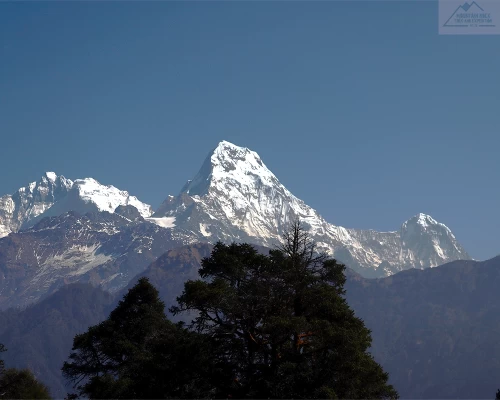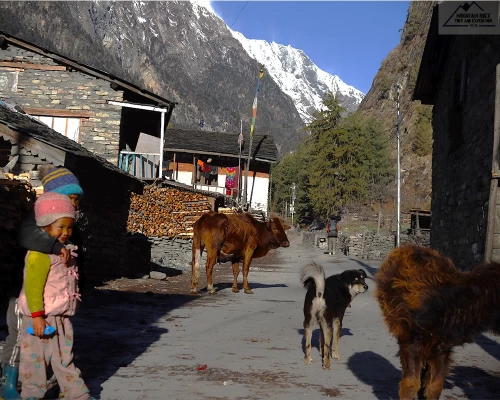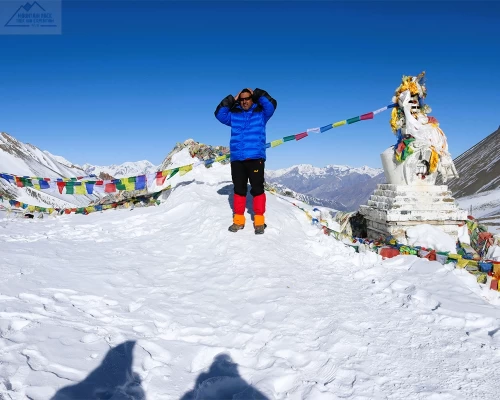1.TRAVEL INSURANCE
Our main priority is the safety of our visitors. So we suggest. If you consider an Annapurna Trek, you should consider purchasing travel insurance to cover any unexpected costs due to health difficulties, injuries, or accidents (including air ambulance, helicopter rescue, and other treatment costs). It will help if you take travel insurance and medical and accidental insurance.
Your insurance coverage should also cover any additional activities you plan to participate in while in Nepal. There's a thin line between adventure and outright danger. What distinguishes them is their level of preparedness for a specific task. Leaving the comforts of home and entering the embrace of nature is an adventure; failing to ensure that you are adequately covered is a danger.
2. Food and Accommodation
I)Food
As for food, the Annapurna region has many hotels and tea houses that facilitate you with the best food items.
Our package will offer you full-time food with breakfast, lunch, dinner, and tea and coffee. We will give the food as per the menu of the hotel or tea house. We prioritize Nepali food mainly. Therefore, they will serve Nepali food items, but if you wish to have a western food item, they will also prepare it upon your request.
II)Accommodation
For accommodation in the Annapurna region, you can find hotels, lodges, and restaurants. From mid-range to expensive resorts can be seen. While trekking, you may need to stop at local villages where you cannot find such facilities. The lodge costs a bit high than other options like the hotel. However, We will arrange your accommodation in tourist comfort hotels, motels, or resorts. The hotel will provide the room with a twin bed which demands you to share your room. In your demand, we can also arrange a triple bed or a single bed which cost a bit expensive compared to others.
3. Heath /Fitness And Experience Requirments
Because some portions of the climb are very strenuous and some days need 8-9 hours of constant walking, trekking throughout Annapurna Region requires exceptional stamina, tenacity, and good health. As a result, we recommend that you get medical counsel, medicine, and authorization before embarking on this adventure. Also, consult your local General Practitioner for professional advice on the essential Guide walks before embarking on the Annapurna Trek in Nepal. However, if you don't have access to a doctor, travel clinics can provide you with the most excellent guidance.
4. Travel Tips (ATM, ELECTRICITY, INTERNET, LUGGAGE, PERSONAL EXPENSES)
As mentioned earlier, we can find all types of hotels and lodges starting from mid-range to very standard. But if we are moving to the local community, we might not find clubs and hotels with all kinds of facilities.
As for the facilities, there is no electricity in all of those locations. Therefore, it is preferable to have a backup plan. We may still use batteries and chargers for backup, but additional expenses will be. There are charging stations in the lodges where you may set your devices. You may have to pay a minimal cost for the service. Bring along additional chargers or a solar charger.
There may not be internet access in all locations, limiting your ability to use data. You may have to pay extra to utilize the internet. The internet connection throughout the walking trail is sporadic at best, and it only worsens as you climb higher.
Having cash on hand for your payments is recommended due to the lack of ATMs. It would help if you had to pay for things like power, internet, and other extras like bakeries and pastries and cash for tipping. Please bring extra cash to spend while trekking because there are no ATMs as we move to higher altitudes. You may need money on the road to buy additional beverages, food, or luxuries like a hot shower, internet, etc.
In the hotel's locker room, provide free spaces for extra luggage. Each hiker can bring up to ten pounds of trekking tools (carried by porters). There aren't any ATMs, so have plenty of cash! Even in a "main" community like Jomsom, you might not find an ATM in the Annapurna region. Almost no tea houses or commercial enterprise accepts credit cards.
5. Altitude Sickness And Prevention
While trekking to the Annapurna region, moving to higher elevations will cause altitude sickness. In addition, you will be more likely to face AMS, which might worsen HACE( High Altitude Cerebral Edema) and HAPE(High Altitude Pulmonary Edema).
When people are traveling and rising or being moved to a higher level fast, altitude sickness is prevalent. Because lower the air pressure and oxygen levels are, the higher you climb. Our bodies can handle the change, but it will take time to acclimate.
So to prevent AMS, we will take two acclimatization breaks every thousand meters. We will trek at a higher altitude but sleep lower to cure this altitude sickness. If we suffer from acute mountain sickness, we will take rest immediately at the same place. To energize, we will drink more liquid to stay hydrated, like soup and water. If the case starts to get worse, we will have to take rescue by helicopter.
6. WHAT SHOULD I BRING?
The following is the list of the things and equipment that we will need to carry with us when you are heading on the journey.
1. For the upper part of the body
HAT: You'll need a nice, wide-brimmed trekking hat to keep the sun off your face. Lightweight, simple to carry, and neck-covering styles are the best. While trekking, wearing a hat can protect yourself from the sun on the trail.
HEADLAMP: Along with the hat, it is better to carry a headlamp with you during the trek. Headlamps are lights we can wear on a person's head. Due to their hands-free operation, these gadgets are great for trekking and hiking. It's ideal to have your hands free when hiking so you can deal with anything Mother Nature throws at you or pull your stuff.
At night, trails can be hard to navigate. These footprints generally incorporate pebbles, tree roots, twigs, and even animals and resemble an uncharted maze. These hazards can be dangerous, and having your hands free allows you to catch yourself, move obstacles, sprint, or fend off an enraged rabbit on the track.
WOOLEN HAT: When you move to higher elevations, you get a high chance of being caught by cold. So, it is essential to carry a woolen hat with you for your protection. Not every hat is equally suitable for trekking, so it is safer to have a woolen hat; it will be available to you if you need it.
SUN PROTECTING HAT(WITH WIDE BRIM): Day during your trial can be sunny, and the rays directly showered upon you. It will protect UV rays from entering your skin. We must be more careful regarding our heads and protect the scalp from sunburn and skin cancer.
SUNGLASSES(WITH UV PROTECTION): As we move towards high altitude, the atmospheric layer becomes thinner, which increases exposure to harmful rays because the capacity to filter these rays becomes less. Therefore, we need to carry sunglasses to protect our eyes from harmful rays.
2. BODY PART
Waterproof jackets and trousers: Rain on the path is always possible, especially if you intend to hike between June and September (we strongly advise against walking in the region). We recommend bringing rain gear with you as a precaution, preferably a gore-tex membrane hardshell jacket. An inexpensive pair of waterproof pullovers will typically be enough for pants.
T-SHIRT: It is better to wear light clothes to avoid extreme sweating and discomfort during trekking. A t-shirt is best to wear during such trips.
Clothing: Layering is a significant walk component due to the considerable fluctuation in altitude and temperature. You'll be able to quickly adapt to the climate and be comfortable and safe if you can add and remove layers of clothes while trekking. For example, if you intend on hiking during the cooler winter months of December through February, you'll want to bring some extra layers.
GLOVES: You will need to carry your gloves with you because gloves will help protect your hands from sweat, extreme weather conditions, and other inconvenient situations that may cause discomfort and injury.
LOWER BODY CLOTHING
THERMAL INNERS: Thermal inners are insulators between your body and the surrounding cold air. They trap body heat and prevent heat loss. Use the ones generally made with polyester or give extra comfort and flexibility.
TROUSERS: A full-length pair of trekking trousers provides solid path protection, preventing cuts and scratches from prickly plants, twigs, rocks, and other hazards. Trekking trousers allow you to travel much easier without the sound of rustling plants and enable you to get near to animals without making a nuisance.
DOWN JACKET: One of the most significant purchases you'll make is a down jacket. On a hiking or climbing journey throughout the journey, having the correct warm, insulating layer may make or break your pleasure level. So when you are heading for a trek in the Everest region, we must include a down jacket in your packing list.
3. FOOTWEARS
TREKKING BOOTS: Trekking boots are necessary as they help to protect the foot and ankles during long-distance trekking. They are one of the essential items of trekking as they can determine a trekker's ability to walk long distances without injury.
SOCKS: A trekking sock is essential for avoiding blisters. Unlike a weak, stinking cotton sock, a hiking hose will not continually brush against the back of your foot and will give substantial protection from friction caused by your shoe. The socks maintain a constant temperature for the feet. Socks are incredibly soft and comfortable on foot.
4. OTHER TYPES OF EQUIPMENT FOR TREKKING
TREKKING POLES: Trekking poles intersperse your arms and shoulders into the trekking movement, allowing you to use better muscles to force yourself uphill and control your downhill. The result is an expansion in rate without an accumulation in leg soreness.
FIRST-AID KIT: First aid kits are a must-have for every trekker. They help you with necessary treatment during the trial. Thus to minimize the risk of infection or injury severity, we must take it with ourselves. A well-stocked kit contains items that treat burns, injuries, scrapes, and cuts.
SLEEPING BAGS: Though we will be staying in hotels and there will be services, still take no risk and carry a sleeping bag with you. If you want the best night's sleep on the trail, it is best to take your sleeping bags.
PERSONAL BAGS: When going on an outdoor trek, you want to be sure that you'll be comfortable the entire time. Personal bags are vital if you're hiking a long and challenging walk. The type of trekking backpack you use will significantly impact how pleasant your adventure will be. If you're carrying many goods, you'll need a bag that distributes the weight properly, so you don't get tired soon.
7. PASSPORT AND VISA
It is relatively simple to acquire a visa for Nepal. You can apply for a visa at your nearest Nepalese Embassy/Consulate or Mission office in your home country or buy one when you arrive at Kathmandu's Tribhuvan International Airport. To apply for a visa, you'll need two passport-sized photos, US dollar visa costs, and a valid passport for at least six months before your travel. Nationals of the SAARC (India, Bhutan, Sri Lanka, Pakistan, Bangladesh, Maldives, and Afghanistan) and China, on the other hand, do not need a visa to enter Nepal. However, a transit visa is only valid for three days for foreign nationals. As a result, for more extended visits, a permit is necessary.
A passport is very crucial to travel in Nepal. In addition, if you want to do mountain trekking, you will have to get a mountain license.
8. BANKING AND ATM
Our packages usually include meals and lodging, but you may require cash for personal expenses. There is a lower likelihood of finding an ATM or no ATM on the ABC trail. . Before you go on the walk, make sure you have enough cash. As mentioned above, there is no ATM in the Annapurna region everywhere, so It is better not to depend on ATMs for the expenses. The hotels and lodges also mostly accept cash rather than online payments, so it's more convenient to take enough money with you.
9. GUIDES PORTER AND TIPPING SYSTEM IN NEPAL
Solo trekking, group trekking, or a couple of trekking without a guide will be difficult, so it is necessary to take a guide with you whenever you plan to trek. In addition, the trail in the Annapurna region might not be familiar to you if you are traveling for the first time.
Since you will have to carry many trekking equipments, it will be convenient and helpful if you take a porter. The porter will help you maintain the luggage, and the Guide will help you take the right trail.
While traveling, you may face uncertainties. For example, you may suffer from altitude sickness and AMS (Acute mountain sickness), so to help you during such situations, we need to take a guide with us.
As for the tips for guides and porters will set you back 10% of the total price. Ten percent of the cost is for the Guide and porter. Mountain Rock Treks provide sixty percent to the Guide's tips and 40 percent to the porter.
9. BOOKING TERMS AND CONDITIONS
We are flexible with bookings. However, you must pay a 25% deposit when you confirm, with the remainder due upon arrival. There are no hidden fees with us.
If you want to join a group, we have different terms and conditions that you may learn about by contacting us.
Mountain Rock Treks & Expedition Pvt. Ltd. handles all of our reservations. Fill out a Booking Form and send it to the firm together with your deposits and insurance payment to book a package (if applicable). You must pay a non-refundable deposit of 25% of the trip charge at booking for all trips. You can pay the remaining payment once you arrive in Kathmandu and before the tour.
The Company or its Agent should receive the non-refundable deposit. When arranging a custom holiday with the firm, Mountain Rock Treks will advise you of the needed cost for the Treks.
You are booking with a bank transfer or a credit card deposit (Visa or MasterCard).
10. LAST-MINUTE BOOKING FOR ANNAPURNA REGION TREKKING
We are flexible with bookings. However, we are not refundable for last-minute cancellations. To ensure your seat on one of our Annapurna region trekking packages at the last minute, you must pay the entire package amount.
We'll try our best to get everything in order before the deadline. So arrive in Kathmandu at least a day ahead of time for the experience. Please get in touch with us directly for further details.
The cancellation of a Client's order must be made in writing and verified by the Company. The date the Company or its Agents receives the cancellation request will determine the cancellation charge.
You will forfeit the 25% deposit if you decide to cancel at the last minute after you have confirmed it. If you choose to cancel your trip after it has begun for any reason, you will be responsible for the total cost of the trip. Once you've started your journey, we can't give you a refund. Therefore, the Client should obtain cancellation insurance at booking.
HOW DIFFICULT IS THE ANNAPURNA REGION TREK?
- ANNAPURNA BASE CAMP TREKKING (MODERATE)
- ANNAPURNA CIRCUIT TREKKING (MODERATE)
- ANNAPURNA GURUNG HERITAGE TRAIL TREK (MODERATE)
- ANNAPURNA CIRCUIT TREK WITH TILICHO LAKE (MODERATE)
- SHORT ANNAPURNA BASE CAMP TREK (STRENUOUS)
- ROYAL TREK (EASY)
- GHOREPANI SUNRISE TREK (DIFFICULT)
- KHOPRA DANDA TREK (DIFFICULT)
- BAGLUNG PANI AND GHANPOKHARA TREK (DIFFICULT)
- TILICHO LAKE WITH MESOKANTO PASS (DIFFICULT)





.jpg)




